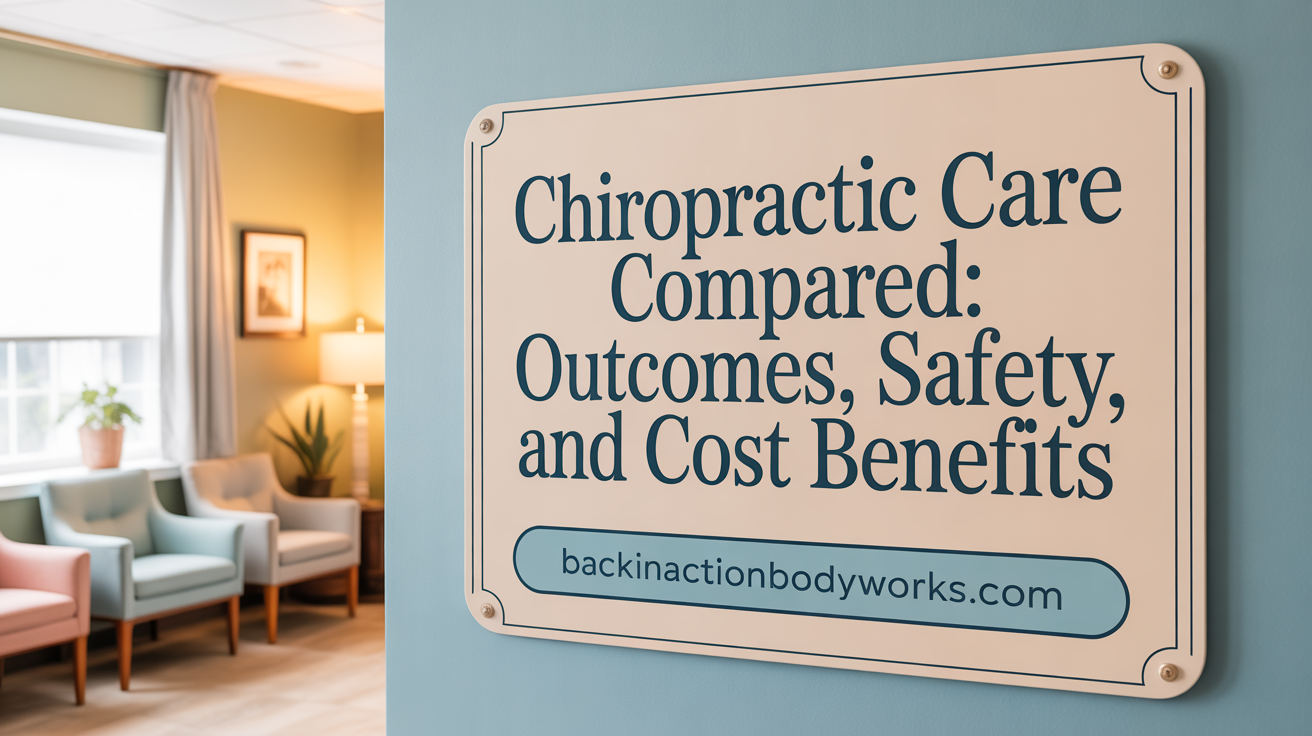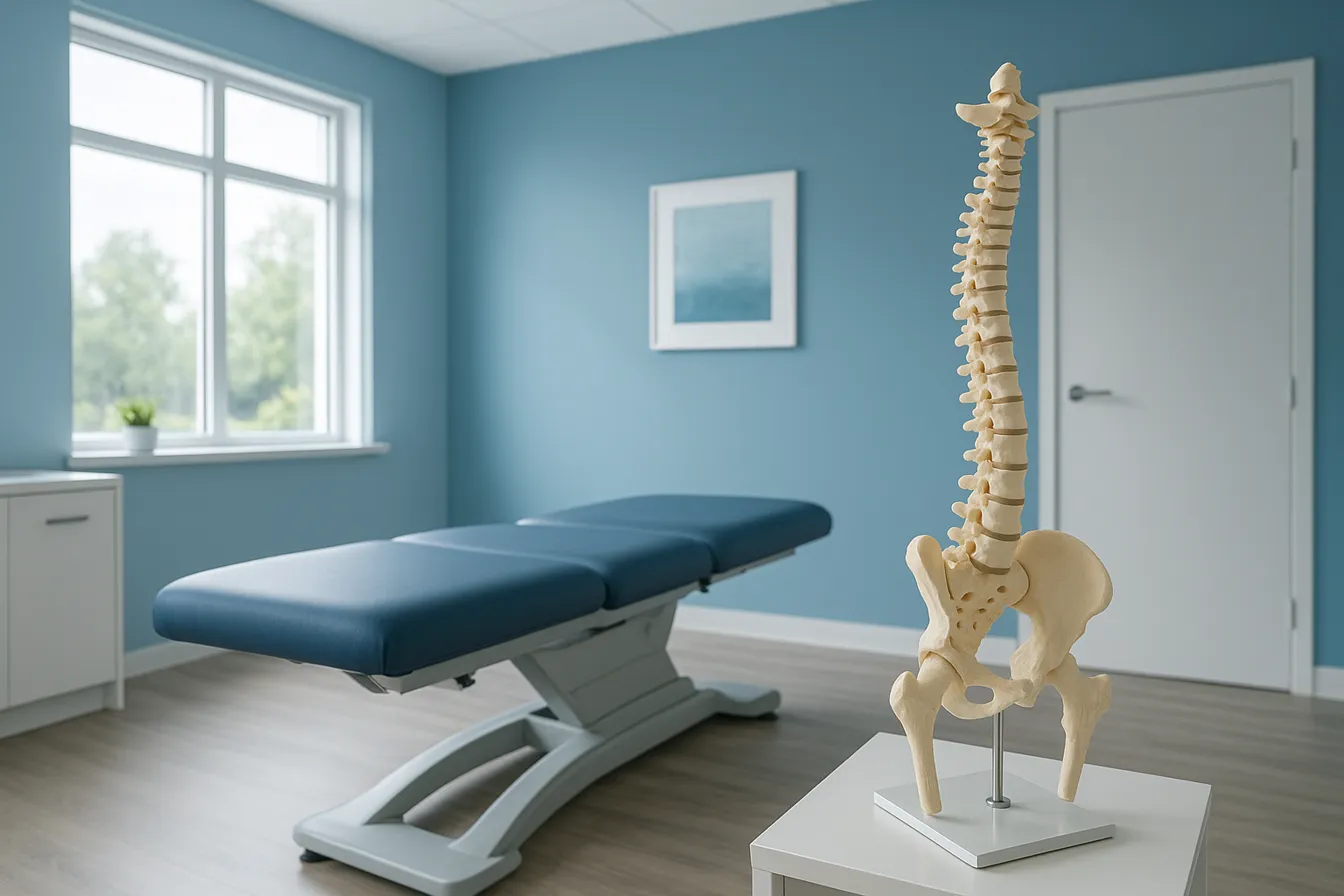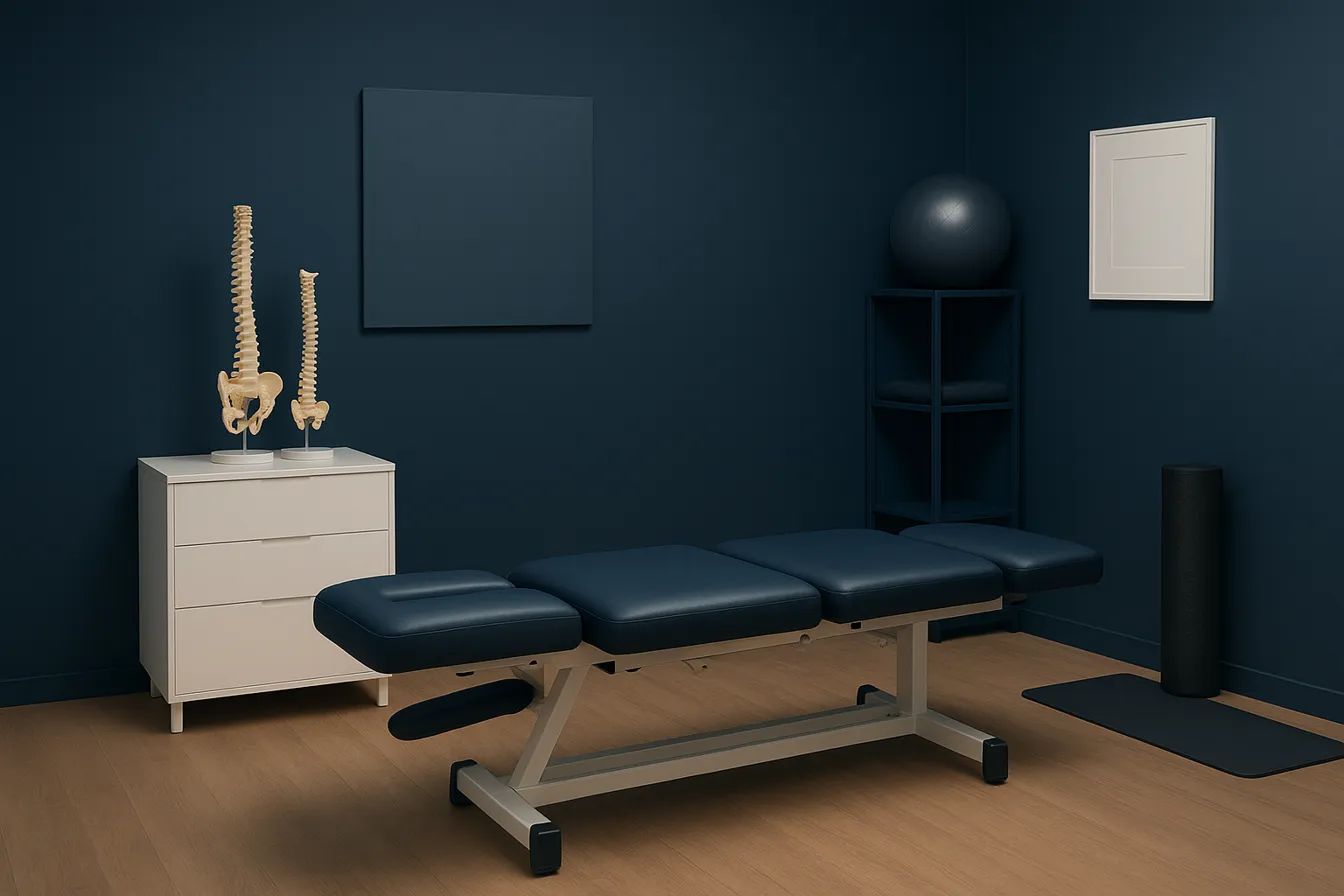Chiropractic Adjustments and Patient Outcomes: What the Statistics Reveal
August 5, 2025
18 min

Understanding Chiropractic Care's Effectiveness
Chiropractic adjustments have long been a subject of debate regarding their efficacy and safety in managing musculoskeletal conditions, particularly back and neck pain. This article analyzes extensive statistical data and scientific research to illuminate the real patient outcomes associated with chiropractic care. By examining clinical research findings, safety profiles, comparative effectiveness, and demographic influences, we aim to present a comprehensive, evidence-based overview of chiropractic adjustments and their role in patient health.
Evidence-Based Foundations of Chiropractic Care
What is chiropractic care and spinal manipulative therapy (SMT)?
Chiropractic care focuses on diagnosing and treating musculoskeletal issues, primarily involving spinal adjustments. Spinal manipulative therapy (SMT) is a core procedure that uses high-velocity, low-amplitude thrusts to improve joint movement, reduce pain, and enhance function. Chiropractors often combine adjustments with other holistic approaches such as exercises, nutrition, and advice on lifestyle.
How well-supported is chiropractic treatment for musculoskeletal conditions?
Scientific research provides considerable support for chiropractic interventions, particularly SMT, in managing back pain, neck pain, and headaches. Multiple studies have shown that SMT can lead to significant pain reduction and improved mobility, often comparable to standard medical care or physical therapy. For instance, patients with chronic low-back pain report about a 30% decrease in pain after treatment, with many experiencing relief within weeks.
Moreover, chiropractic care has been associated with reduced healthcare costs and lower chances of requiring surgeries or medication—highlighting its effectiveness in addressing certain conditions. International and US-based research, including several government and academic studies, affirm the safety, efficacy, and cost-efficiency of chiropractic for specific musculoskeletal issues.
Are clinical guidelines recommending chiropractic care?
Yes, many clinical practice guidelines advocate for the inclusion of chiropractic SMT, especially for lower back pain. The American College of Physicians recommends spinal manipulation as a primary treatment option for this condition. Guidelines favor a multimodal approach that combines SMT with exercise and patient education, emphasizing conservative management first.
Studies such as a 2023 randomized controlled trial involving military personnel demonstrated that chiropractic care can produce moderate short-term improvements in pain and disability, with high patient satisfaction. Additionally, the US Centers for Medicare & Medicaid Services recognize the cost-saving benefits of chiropractic, including substantial reductions in hospital visits and pharmaceutical use.
Limitations in evidence for non-musculoskeletal ailments
While chiropractic care has strong backing for its role in treating back and neck pain, evidence supporting its use for other health conditions is limited. Systematic reviews and research generally do not support the efficacy of chiropractic interventions for diseases outside the musculoskeletal realm, such as asthma, gastrointestinal issues, or systemic illnesses.
Furthermore, some core concepts in chiropractic, such as subluxation as the basis for health, lack scientific validation. Risks, especially related to cervical spine adjustments, are extremely low but still present, including serious vascular accidents, though these are rare. In general, the efficacy and safety of chiropractic for non-musculoskeletal conditions remain uncertain, highlighting the need for further high-quality research.
Statistical Overview of Chiropractic Care Utilization and Safety
What are the statistical findings on the efficacy and safety of chiropractic care?
Research consistently supports chiropractic care as a safe and effective treatment option for various musculoskeletal conditions, especially lower back pain, neck pain, and headaches. Nearly half of all complementary and alternative medicine (CAM) visits in the U.S. are for chiropractic services, with over 35 million Americans seeking chiropractic care annually.
Patient satisfaction rates are high, with around 77% describing treatment as very effective and 94% experiencing at least a 30% reduction in pain. Studies show that chiropractic interventions can lead to significant pain relief, improvement in range of motion, and functional outcomes, often outperforming conventional medical care in patient satisfaction.
Safety data indicate that chiropractic adjustments are very safe when performed by trained and licensed practitioners. Severe adverse events are extremely rare, with serious injury rates estimated at about 1 in 2 million manipulations. Minor side effects such as headache, fatigue, or musculoskeletal discomfort are more common but typically transient.
Additionally, the risk of serious complications like stroke from cervical manipulation is very low, with recent studies finding no increased risk of stroke from chiropractic neck adjustments. Overall, the evidence underscores that chiropractic care is a low-risk, effective treatment modality for specific conditions, especially when administered appropriately.
Demographics of chiropractic patients globally and US-specific data
Globally, there are over 103,000 practicing chiropractors, with more than 70,000 licensed in the United States. In the US alone, over 35 million individuals seek chiropractic care annually, representing roughly 10% of adults. Usage has steadily increased from 9.1% in 2012 to 10.3% in 2017, highlighting growing acceptance and integration into mainstream healthcare.
Most patients are middle-aged adults, and many have experienced pain for several years before seeking chiropractic treatment. Demographically, women and middle-aged individuals tend to utilize these services more frequently, often due to chronic pain conditions like back or neck pain.
Annual patient volume and growth trends in chiropractic visits
Chiropractic visits in the US amount to approximately 280 million annually, reflecting a steady increase over recent decades. The growth trend is driven by increased awareness of chiropractic benefits, patient satisfaction, and supportive clinical guidelines.
Safety statistics including injury and fatality risk
Chiropractic care is associated with a very low injury risk. Data estimate serious adverse events occur at a rate of about 1 in 2 million manipulations. Fatality risks, particularly related to neck adjustments, are estimated at approximately three in 10 million patients.
Common minor side effects and severity of adverse events
Most adverse effects reported are minor and temporary, including soreness, headache, or fatigue, which usually resolve within a few days. Serious injuries such as herniated discs or nerve damage are rare, but vigilance and proper assessment are essential, especially for contraindicated individuals.
| Aspect | Statistic | Additional Details |
|---|---|---|
| Percentage of U.S. adults who have visited a chiropractor | 50% | Includes lifetime and recent users |
| Annual chiropractic visits | 280 million | Most common musculoskeletal treatment in the US |
| Patient satisfaction rate | 83-94% | Higher than conventional treatments |
| Injury rate | 1 in 2 million manipulations | For serious adverse events |
| Fatality rate | 3 in 10 million | For neck manipulations |
| Use of chiropractic for chronic conditions | Significant relief in pain, mobility, and chronic headaches | Supported by multiple clinical studies |
The data collectively reinforce that chiropractic care is a widely used, generally safe, and effective approach for managing various musculoskeletal conditions, with very low associated risks when performed by licensed professionals.
Patient Outcomes: Pain Reduction and Functional Improvements
What are the typical patient outcomes and success rates following chiropractic adjustments?
Research indicates that chiropractic care, especially spinal manipulative therapy (SMT), often leads to effective relief from pain and improvements in function for various musculoskeletal conditions. For instance, patients with chronic low-back and neck pain show modest but meaningful reductions in pain levels over a three-month period. On a 0-10 scale, low-back pain decreased by approximately 0.40 points, while neck pain reduced by about 0.44 points.
Functional disability scores also improve with chiropractic treatment. Measures like the Oswestry Disability Index (ODI) and the Neck Disability Index (NDI) saw reductions of around 2.7 and 3.0 points respectively on their 0-100 scales. These changes suggest enhanced ability to perform daily activities, contributing to better quality of life.
Many patients report high satisfaction with chiropractic care, with over 77% describing it as very effective, and 94% experiencing at least a 30% reduction in pain. Notably, these improvements are often achieved relatively early, sometimes within weeks, and are associated with high levels of perceived recovery.
Safety remains a consideration, but the adverse effects are typically minor and transient, such as headaches or fatigue, with serious complications being extremely rare. The overall success rate is supported by systematic reviews and randomized controlled trials, which affirm that chiropractic adjustments can be a valuable component of treatment for spine pain.
Additionally, the influence of baseline severity plays a role in outcomes. Patients with worse initial pain and functional impairment tend to have more frequent visits—particularly more than once per week—and tend to experience greater improvements. Most symptoms tend to plateau after some weeks of care, suggesting that patients often reach a maximum therapeutic benefit and may shift focus towards maintenance.
In summary, chiropractic care offers a relatively safe, effective short-term solution for managing musculoskeletal pain, with significant patient satisfaction and functional gains supporting its role in conservative treatment strategies.
Comparative Effectiveness: Chiropractic Versus Other Treatments
 Numerous studies and clinical trials have examined how chiropractic care stacks up against alternative treatments for both back and neck pain.
Numerous studies and clinical trials have examined how chiropractic care stacks up against alternative treatments for both back and neck pain.
Research indicates that chiropractic interventions, especially spinal manipulation, are roughly as effective as other conventional therapies such as physical therapy, medical management, and minimal intervention approaches. Randomized controlled trials have shown that patients receiving chiropractic care often experience similar, if not better, improvements in pain relief and functional outcomes compared to those undergoing standard medical care.
For instance, a study involving adults with low back pain found that chiropractic manipulation produced less severe symptoms after four weeks compared to minimal interventions like educational booklets. Meanwhile, direct comparisons between chiropractic and physical therapy revealed comparable symptom reduction over treatment periods, with each approach showing benefits without significant differences in costs or safety.
Evidence also suggests that chiropractic care may reduce overall healthcare utilization. Patients who start with chiropractic treatment often incur fewer hospital visits and are significantly less likely to need surgery or opioids. A large-scale study indicated that receiving chiropractic care as an initial therapy for low back pain decreased the odds of opioid prescriptions by 90%, highlighting its role in combating medication overuse.
In terms of safety, chiropractic treatment demonstrates a very low risk profile, comparable to or lower than other manual therapies, with serious adverse effects rare and predominantly associated with neck manipulations.
Furthermore, most clinical guidelines endorse combining chiropractic care with other modalities, such as exercise programs, to optimize outcomes—demonstrating its effectiveness when integrated into multidisciplinary treatment plans.
In summary, available evidence supports chiropractic care as a safe, effective, and cost-efficient option for managing back and neck pain. Its outcomes are comparable to traditional treatments, and it offers potential benefits in reducing healthcare costs and medication dependency.
Search terms for further research:
| Study Focus | Findings | Source |
|---|---|---|
| Chiropractic vs. physical therapy | Similar pain reduction and functional improvements | Clinical Trials |
| Chiropractic and medical care | Comparable outcomes for back and neck pain | Randomized Trials |
| Healthcare utilization and costs | Lower costs and reduced surgery rates | Systematic Reviews |
| Opioid prescription reduction | Significant decrease when chiropractic used initially | Population Studies |
| Integration in multidisciplinary care | Improved patient satisfaction and outcomes | Clinical Guidelines |
Mechanisms Behind Chiropractic Adjustment Benefits

What mechanisms underlie the clinical benefits observed after chiropractic adjustments?
Chiropractic adjustments provide relief through a combination of biomechanical and neurophysiological mechanisms. Biomechanically, adjustments aim to restore proper joint alignment and enhance mobility, which can reduce nerve irritation, muscle tension, and inflammation. This aligns with the observed improvements in pain and function, especially in conditions like low back and neck pain.
Neurophysiologically, spinal manipulation may trigger responses within the nervous system that modulate pain signals and improve communication between the brain and body. This can promote natural pain relief, decrease muscle spasms, and enhance overall nervous system function.
Scientific studies employ advanced statistical methods—such as hypothesis testing, regression analysis, and correlation measures—to validate these mechanisms. These methods help demonstrate that improvements in clinical outcomes are not due to chance but are significantly linked to chiropractic interventions.
Moreover, the reliability of these findings depends on adequate sample sizes, assessments of data distribution, and transparent research methodologies. Large, well-designed studies strengthen the evidence base, confirming that the observed benefits are reproducible and scientifically sound.
In conclusion, chiropractic adjustments work through interconnected biomechanical and neurophysiological pathways, with validated statistical evidence underpinning their efficacy, providing a scientific foundation for understanding how they alleviate pain and improve function.
Demographic Influences on Chiropractic Care Utilization and Outcomes
What demographic factors influence the utilization and outcomes of chiropractic care?
Various demographic factors play a significant role in how chiropractic care is accessed and its results. Age is an important aspect, with younger adults, especially those between 18 and 30 years old, more likely to seek chiropractic treatment. This tendency is often associated with the prevalence of musculoskeletal issues such as back and neck pain, which are common in this age group.
Gender also influences utilization patterns. Females are generally more inclined to use chiropractic services and report positive experiences. Their higher engagement may be linked to greater health awareness or cultural perceptions of alternative treatments.
Ethnicity and cultural background further impact care seeking behaviors. Studies indicate that non-Bumiputra populations tend to have higher awareness and acceptance of chiropractic medicine, possibly due to increased exposure through media, education, or social networks.
Sociodemographic variables such as employment status and education level can affect perceptions of treatment effectiveness and satisfaction. For instance, students and highly educated individuals often demonstrate greater interest in alternative therapies, partly driven by the ease of access and information availability on the internet.
Patterns of chiropractic service usage among different populations
Analysis shows that single individuals are more likely to seek chiropractic care, potentially because of fewer family or work commitments. This group often utilizes services for acute or chronic musculoskeletal issues like back and neck pain.
In addition, awareness of chiropractic treatments varies across communities, with younger, urban populations showing higher engagement. Many patients report that their extended use over years correlates with perceived benefits and satisfaction.
Impact of sociodemographic factors on treatment satisfaction and outcomes
Patients’ backgrounds influence their satisfaction levels and perceived outcomes. Those with higher health literacy and better access to information tend to report more favorable results.
Cultural factors may shape expectations, trust in the chiropractor, and openness to treatment modalities such as spinal manipulation.
Higher satisfaction scores are often linked with personalized care that considers patients’ cultural preferences, lifestyle, and specific health goals.
Relevance of personalized approaches in chiropractic treatment
Considering the demographic diversity among patients, a tailored treatment plan enhances effectiveness and patient satisfaction. Recognizing demographic influences allows chiropractors to adapt communication styles, treatment strategies, and follow-up care.
In summary, demographic factors significantly influence who seeks chiropractic care, their treatment experiences, and outcomes. Emphasizing personalized, culturally sensitive approaches can optimize the benefits of chiropractic interventions for diverse populations.
| Demographic Factor | Impact on Utilization | Impact on Outcomes | Notable Trends |
|---|---|---|---|
| Age (18-30) | Higher participation in chiropractic services | Better engagement with treatment | Younger adults seek more proactive care |
| Gender | Females more likely to use and report satisfaction | Higher satisfaction scores | Females show higher health awareness |
| Ethnicity | Non-Bumiputra more aware of chiropractic | Perceived effectiveness varies | Cultural familiarity influences acceptance |
| Employment Status | Students and employed individuals more likely to seek care | Perceived outcomes influenced by access | Urban populations exhibit higher usage |
| Cultural background | Impacts trust and treatment expectations | Tailored care improves satisfaction | Personalized approaches improve results |
Safety Profile and Risk Assessment of Chiropractic Adjustments
What are the statistical findings on the efficacy and safety of chiropractic care?
When performed by trained and licensed professionals, chiropractic adjustments are associated with a very low risk of adverse effects. Minor side effects such as headaches, fatigue, or mild soreness are relatively common but typically short-lived and self-limiting.
Serious complications, although exceedingly rare, have been documented. The estimated incidence of severe adverse events, such as vascular injury or stroke following neck manipulation, is approximately 1 in 2 million to 10 million manipulations.
Fatal outcomes are even less frequent, with estimates around three cases per 10 million neck manipulations. These safety figures highlight the rarity of serious harms associated with chiropractic care.
Statistical risk comparison with other medical interventions
Compared to many invasive medical procedures, chiropractic adjustments have a significantly lower incidence of adverse events. For example, surgical interventions for spinal issues carry higher risks of complication, including infection or nerve damage.
Research also shows that chiropractic care has a lower rate of adverse effects compared to some pharmaceutical treatments, particularly opioids, which carry risks of dependency and overdose.
Reported rare complications such as vascular injury and stroke
Concerns regarding cervical spine manipulation involve reports of vertebral artery dissection and subsequent stroke. While these events are rare, they garner considerable attention because of their severity.
Multiple studies, including reviews in Spine Magazine and the Journal of Manipulative and Physiological Therapeutics, indicate that the risk of stroke from cervical manipulation is very low, with some research suggesting no increased risk compared to that in the general population.
Comprehensive analysis suggests that the causal link between chiropractic adjustments and stroke is not definitively established, and the overall risk remains minimal.
Regulatory standards and professional licensing ensuring safety
Chiropractic practitioners in the U.S. and many other countries must meet stringent licensing and certification standards. These include rigorous educational requirements, examinations, and continuing education to ensure adherence to safety protocols.
Regulatory bodies oversee practice standards and investigate adverse events, helping to maintain high-quality care. The low incidence of serious injuries is partly attributable to these safeguards.
While no medical intervention is without risk, the cumulative evidence underscores that chiropractic adjustments, when performed by qualified practitioners, are generally safe and effective for appropriate patients.
Controversies and Criticisms Surrounding Chiropractic Science
What controversies or criticisms exist regarding the scientific validity of chiropractic treatments?
Chiropractic care is a popular form of alternative medicine, but it has attracted significant criticism related to its scientific foundation. Central controversies revolve around core concepts like subluxation and spinal manipulation, which lack solid scientific evidence. Many critics believe that the idea of spinal subluxations as root causes of health problems is rooted in mystical and metaphysical notions rather than empirical science.
While chiropractic demonstrates proven effectiveness for certain musculoskeletal issues such as low back pain and headaches—supported by numerous studies and endorsed by clinical guidelines—its broader claims are highly disputed. Specific assertions, like boosting the immune system or treating non-musculoskeletal diseases through spinal adjustments, are largely considered pseudoscientific due to the absence of rigorous evidence.
Risks associated with chiropractic interventions further amplify the debate. Mild side effects like headaches and fatigue are common, but there are rare, serious complications such as vertebral artery dissection leading to strokes, especially with neck manipulations. These rare adverse events raise questions about safety, particularly when the scientific basis for some practices is questionable.
The quality of research supporting chiropractic care is also under scrutiny. Many studies are criticized for methodological biases, small sample sizes, or conflicts of interest. Systematic reviews often conclude that while chiropractic can be effective for specific pain conditions, the evidence for broader health claims remains weak.
In summary, advancements in scientific understanding have not fully validated many chiropractic principles. This ongoing debate continues to influence perceptions within the medical community and impacts policy formulations for healthcare integration and coverage.
Economic Impact and Healthcare Cost Savings

How does chiropractic care compare financially with conventional medical care?
Chiropractic treatment is often more cost-effective than traditional medical approaches for spine-related conditions. Studies indicate that chiropractic care can be about 40% more economical, mainly due to fewer hospitalizations and procedures required. Patients typically experience greater pain relief and functional improvement quickly, which can reduce overall treatment expenses.
How does chiropractic care reduce reliance on pharmaceuticals and hospital visits?
Using chiropractic services has been linked to an 85% reduction in the need for medications, especially opioids, which are often prescribed for chronic back pain. Additionally, patients enrolled in chiropractic care are about 60% less likely to visit hospitals for pain management, leading to significant savings in hospital resources and costs.
What are the financial benefits for healthcare systems like Medicare?
Medicare savings are notable, with reports showing that chiropractic care can save over $83 million annually by replacing costly doctor visits for back pain. Not only does this benefit the system financially, but it also potentially reduces the burden on hospital and surgical facilities.
Does chiropractic care influence surgery rates and overall healthcare expenses?
| Aspect | Effect | Additional Details |
|---|---|---|
| Surgery rates | Significantly lower | Patients who see chiropractors first are 28 times less likely to undergo spinal surgery. |
| Overall costs | Reduced | Patients with musculoskeletal issues initial treatment with chiropractic services incur fewer healthcare charges overall. |
| Long-term savings | Substantial | Chiropractic treatments can lead to shorter episodes of illness, quicker recovery, and less need for invasive procedures. |
The cumulative effect of these savings underscores chiropractic care’s important role in reducing healthcare expenditure, emphasizing its value as a primary approach for managing spine and musculoskeletal conditions effectively and economically.
Patient Satisfaction and Perceived Effectiveness
High satisfaction ratings and factors influencing positive patient perceptions
Many patients report high satisfaction levels with chiropractic care, often exceeding 75%, and sometimes reaching 95%. These positive perceptions are largely influenced by the quality of communication, trust in the practitioner, and personalized care. Patients value the active involvement of chiropractors in their health journey, which promotes feelings of support and confidence.
Comparisons of satisfaction between chiropractic and other healthcare approaches
Studies consistently show that chiropractic patients are more satisfied compared to those receiving traditional medical treatments. For instance, surveys indicate that over 77% of chiropractic patients find the care very effective, outperforming conventional approaches. High satisfaction scores are often linked not only to symptom relief but also to shorter wait times and longer, more informative consultations.
Role of communication, empathy, and therapeutic relationship
A strong therapeutic relationship, rooted in empathy and good communication, significantly boosts patient satisfaction. Patients appreciate when chiropractors listen carefully, explain procedures clearly, and involve them actively in decision-making. This personalized approach enhances trust and can lead to better treatment compliance and perceived effectiveness.
Patient-reported outcomes and trust in chiropractors
The majority of patients report substantial improvements in pain and overall well-being after chiropractic care. Trust levels are remarkably high, with many patients citing confidence in their chiropractor’s expertise and honesty. Such trust contributes positively to treatment outcomes and reinforces the perception that chiropractic care is both safe and effective.
| Aspect | Patient Outcomes/Impact | Notable Findings |
|---|---|---|
| Satisfaction Ratings | 75-95% report high satisfaction | Significantly higher than traditional medical care |
| Factors Influencing Satisfaction | Communication, empathy, trust | Personalization and active engagement improve perceptions |
| Comparative Satisfaction | Chiropractic often rated higher | More positive experiences linked to provider interaction |
| Trust and Outcomes | High trust correlates with better results | Over 80% trust levels, enhancing treatment success |
This focus on communication, trust, and personalized care explains why many patients view chiropractic treatment as highly effective, fostering positive feelings and strong confidence in their healthcare experience.
Long-Term Management and Maintenance in Chiropractic Care

How do symptoms plateau and what is the maximum therapeutic benefit over time?
Patients undergoing chiropractic care for chronic back and neck pains often experience an initial period of symptom improvement. Over approximately three months, both back and neck pain decrease slightly—by about 0.40 and 0.44 points respectively on a 0-10 scale. After this period, many symptoms tend to level off, indicating that patients have likely reached their maximum benefit from therapy. This plateau suggests continued care may shift focus from reducing pain to maintaining health and preventing recurrence.
How should chiropractic visits be tailored to individual needs?
Patients with more severe symptoms or worse baseline function generally require more frequent visits. Those with chronic low-back pain, especially, tend to benefit from visits more than once a week. This intensified care correlates with better overall improvements, highlighting the importance of customizing treatment plans based on individual pain levels and functional impairment.
What is the role of chiropractic care in managing chronic conditions and ongoing pain?
Chiropractic care plays a significant part in the management of long-term spine conditions. Evidence shows that many patients experience modest reductions in pain and disability over extended periods. With most symptoms reaching a plateau, continued care often aims at maintenance and prevention rather than further symptom reduction. Furthermore, current policies should consider that many patients perceive their pain as lower during ongoing care, compared to their pain levels without treatment.
What are the implications for healthcare coverage and policy?
Because many patients achieve stabilization in symptoms, policies mandating continual improvement as a requirement for ongoing insurance coverage might not align with patient management strategies. Recognizing that benefits plateau for many after some months could support policies that favor maintenance-focused care, reducing unnecessary treatment and controlling healthcare costs. Additionally, evidence indicates that chiropractic care is effective, safe, and cost-efficient, particularly in reducing reliance on pharmaceuticals and decreasing hospital visits.
| Aspect | Details | Additional Notes |
|---|---|---|
| Symptom improvement | Slight and often plateaus after ~3 months | Emphasizes the importance of setting realistic treatment expectations |
| Visit frequency | More visits linked to worse baseline symptoms, more improvement | Individualized care contributes to optimal outcomes |
| Long-term role | Focus on maintenance and preventing recurrence | Not solely aiming for further pain reduction |
| Policy implications | Reconsider coverage rules focusing on improvement | Support for maintenance-based treatment models |
Chiropractic care remains a cost-effective, safe, and patient-preferred approach for managing chronic spine pain. Recognizing the natural plateauing of benefits can lead to more personalized care plans and pragmatic insurance policies that support sustainable, long-term health management.
Integrating Statistical Insights on Chiropractic Care
The statistical evidence and scientific research reviewed affirm that chiropractic adjustments, especially spinal manipulative therapy, provide meaningful benefits for patients experiencing certain musculoskeletal conditions like low back pain, neck pain, and headaches. They often yield significant reductions in pain and improvements in function with favorable safety profiles and high patient satisfaction. While chiropractic care compares well to other treatment modalities and offers economic advantages, controversies persist regarding the broader scientific validity and applicability beyond musculoskeletal disorders. Understanding demographic variations and long-term management considerations further informs optimal patient care strategies. These insights highlight the value of chiropractic adjustments as an evidence-supported option within comprehensive healthcare approaches, underscoring the need for continued rigorous research to enhance knowledge and patient outcomes in the field.
References
- Visit Frequency and Outcomes for Patients Using Ongoing ...
- Chiropractic Statistics and Facts for 2023
- Clinical Effectiveness and Efficacy of Chiropractic Spinal ...
- What Research Shows - American Chiropractic Association
- Chiropractic Statistics - Kutest Kids
- The Numbers Tell the Truth, Chiropractic works!
- Chiropractic Statistics - Yellow Bus ABA
Recent articles

Chiropractic Care: Key Benefits for Managing and Preventing Back Pain

Corrective Exercises That Support Long-Term Relief from Sciatica

Chiropractic Methods That Provide Lasting Relief from Back Pain

Understanding Spinal Decompression and Its Benefits for Sciatica

Real Patient Testimonials: Success Stories in Chiropractic Care

Top Questions to Ask Your Chiropractor During Your Initial Visit

Physiotherapy's Role in Supporting Chiropractic Treatment Plans

The Role of Diet and Nutrition in Enhancing Wellness and Chiropractic Care

Inspiring Patient Testimonials Highlighting Chiropractic Success

Chiropractic Care: A Natural Solution for Back Pain Relief

Amazing Patient Success Stories in Chiropractic Wellness

Combining Physiotherapy and Chiropractic for Optimal Healing

Spinal Decompression Therapy: A Breakthrough for Sciatica Sufferers

5 Holistic Treatments That Complement Chiropractic Care

How Physiotherapy Supports and Enhances Chiropractic Treatment

Root Cause Versus Symptom Treatment: Making the Right Choice

7 Essential Things to Know Before Choosing Your Chiropractor

Why Addressing Root Causes of Pain Matters More Than Just Symptoms

Nutritional Counseling Strategies to Boost Your Overall Wellness

How Spinal Decompression Therapy Alleviates Sciatic Nerve Pain

Long-Term Pain Relief Through Targeted Corrective Exercises

10 Benefits of Integrating Physiotherapy with Chiropractic Treatments

Corrective Exercises That Help Prevent Recurring Pain

8 Corrective Exercises Proven for Lasting Pain Relief

Lifestyle Habits for Maintaining a Healthy Spine

What You Will Experience at Your Initial Chiropractic Visit

What Happens at Your First Visit to a Chiropractor?

Focusing on Root Cause Analysis for Effective Pain Relief

Tips for Lifestyle Changes to Support Spinal Health

Tips for Lifestyle Changes to Support Spinal Health

Holistic Treatment Plans: Alternatives to Surgery for Chronic Pain

Enhance Wellness Through Personalized Nutritional Counseling

Non-Invasive Pain Relief: Exploring Holistic Treatment Alternatives

Sciatica Relief Through Targeted Spinal Decompression

Integrating Physiotherapy with Chiropractic Treatments for Better Results

Testimonials That Demonstrate the Benefits of Chiropractic Care

The Power of Corrective Exercises in Pain Management

A Step-by-Step Guide to Your Initial Chiropractic Consultation

9 Nutritional Tips to Enhance Your Chiropractic Wellness Journey

Patient Experiences: How Chiropractic Care Changed Their Lives

Lifestyle Recommendations to Keep Your Spine in Top Shape

Effective Corrective Exercises for Long-Term Pain Relief

Back Pain Benefits: What Chiropractic Care Can Do for You

Spinal Decompression Techniques for Effective Sciatica Relief

Top Nutritional Counseling Tips for Enhanced Wellness

6 Lifestyle Habits That Boost Spine Health Daily

Discover Holistic and Non-Surgical Pain Relief Solutions

Exploring Holistic and Non-Surgical Treatment Options for Pain

The Role of Physiotherapy in Enhancing Chiropractic Care Outcomes

Complementing Chiropractic Care with Physiotherapy: What You Need to Know

What to Expect During Your First Chiropractic Visit

Simple Lifestyle Adjustments to Maintain a Healthy Spine

Personalized Nutritional Counseling for Improved Health Outcomes

Exploring Non-Surgical Treatments for Spine-Related Conditions

An Introduction to Spinal Decompression for Sciatica Patients

Transformative Success Stories: Patient Experiences with Chiropractic Treatments

Why Chiropractic Care Is Essential for Back Pain Relief

Addressing Underlying Causes Versus Symptom Management in Pain Care

The Role of Nutrition in Enhancing Chiropractic Treatment Effectiveness

Sciatica Treatment Options: Is Spinal Decompression Right for You?

Lifestyle Tips to Maintain a Healthy Spine and Prevent Back Issues

The Synergy Between Physiotherapy and Chiropractic Treatments

What Happens During Your Initial Chiropractic Consultation

Effective Corrective Exercises for Sustainable Pain Management

Taking a Root Cause Approach to Chronic Pain Management

Holistic Pain Management Techniques Without Surgery

How Patient Success Stories Validate Chiropractic Care Benefits

Spinal Decompression: Innovative Treatment for Sciatic Nerve Pain

Spinal Decompression Therapy: A Non-Invasive Approach to Sciatica Relief

Exploring Holistic Approaches Beyond Surgery for Pain Relief

Practical Lifestyle Advice to Support a Healthy Spine Every Day

Corrective Exercise Routines Designed for Long-Term Pain Prevention

Real Patient Stories: Overcoming Chronic Pain with Chiropractic Care

Lifestyle Changes That Promote a Healthy Spine and Prevent Injury

How Addressing the Root Cause of Pain Leads to Lasting Relief

Non-Surgical Holistic Therapies to Manage Chronic Pain Effectively

Nutritional Counseling's Impact on Physical Health and Healing

Benefits of Regular Chiropractic Care for a Stronger Back

Your First Chiropractic Visit: What to Expect and How to Prepare

Patient Experiences: How Chiropractic Care Transformed Their Lives

Exploring Holistic, Non-Surgical Options for Pain Management

Combining Physiotherapy with Chiropractic Treatments for Enhanced Recovery

Holistic Treatments That Offer Alternatives to Surgery for Pain Relief

Corrective Exercise Strategies for Long-Term Spine Health

How Physiotherapy Complements Chiropractic Adjustments for Better Outcomes

First-Time Chiropractic Visitors: What You Should Know

Understanding the Importance of Treating Pain at Its Source

Adopting Lifestyle Changes to Support Your Spine's Wellness

Utilizing Physiotherapy to Enhance Chiropractic Treatment Outcomes

The Key Advantages of Chiropractic Care for Back Pain Sufferers

Why Focusing on Root Causes Improves Pain Treatment Success

Corrective Exercises That Promote Lasting Pain Relief and Mobility

Sciatica Relief Through Targeted Spinal Decompression Techniques

Preparing for Your First Chiropractic Appointment with Confidence

Healthy Lifestyle Habits for Maintaining Spinal Alignment

Success Stories Highlighting Chiropractic's Role in Pain Recovery

Top Benefits of Chiropractic Care for Chronic Back Pain

Nutrition Tips to Boost Your Overall Wellness and Recovery

How Chiropractic Care Alleviates Back Pain Naturally

